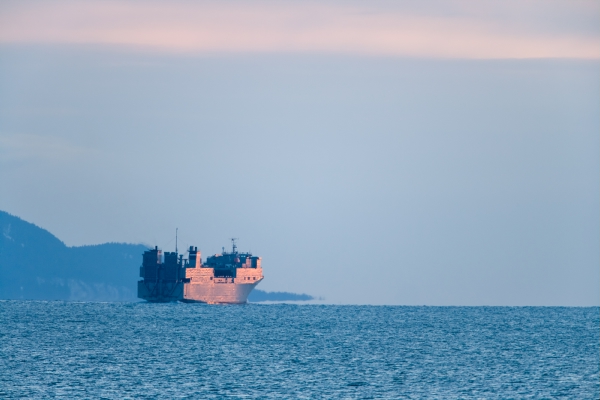What are Scrubbers?
Learn about the increasing use of these ship exhaust gas cleaning systems and how they’re impacting the environment

Like the rest of Ocean Conservancy, I am working from home, tapping out these final lines from the modest comfort of the one table in my apartment. Even though we can’t meet face to face work with environmental leaders, we are still pushing forward to protect the ocean the best we can in these trying times. And, today, I have a blog about scrubbers—to give you a look into some of the work that I do here at Ocean Conservancy.
It may come as a surprise to you but at the beginning of 2020 (either three months or several lifetimes ago), we saw some great news on the shipping front. Let me explain. On January 1st, the permitted level of sulfur in marine shipping fuels dropped from 3.5% to 0.5%, which drastically cuts down a lot of harmful air pollutants across the globe. The not-so-great news is that one way ships can meet this new regulation is by installing “scrubbers,” or exhaust gas cleaning systems. While scrubbers help make our air cleaner, they come with problems of their own.
Let’s see if I can break this down …
In a nutshell, when a ship’s engine burns fuel, it releases exhaust gas. This gas passes through a funnel, which essentially functions as the chimney for the ship by venting the gas away from equipment and crew. Scrubbers often work by spraying water or another alkaline solution on exhaust gas before it exits the funnel, capturing acidic pollutants. The more solid sludge is separated out, which remains on the ship and should be disposed of at ports. On “wet” scrubbers what’s leftover is called “washwater,” and while on a small number of “closed loop” ships it also remains onboard, in roughly 80% of ships the scrubber works on an “open loop.” For these scrubbers seawater goes in, treats the exhaust, and goes back out of the ship as washwater. When discharged, this washwater can contain heavy metals, sulfates, nitrates and polycyclic aromatic hydrocarbons. Polycyclic aromatic hydrocarbons are a potential carcinogen, and have been linked to cancers in Arctic wildlife like belugas. This warm, sulfuric water can also degrade the immediate environment around the discharge.
Impact on Animals
The scale of discharge is also important. A recent analysis by the International Council on Clean Transportation found that just 30 scrubber-equipped ships emitted an estimated 35 million tons of scrubber washwater in the waters near British Columbia in 2017, some of it in critical habitat for the endangered southern resident killer whale population. Given the potential impacts of scrubber discharges, some countries like Singapore have banned their use. But sensitive marine regions like the Arctic are being exposed to the risks of scrubber washwater.
Heavy Fuel Oil
Apart from the immediate effect scrubber washwater can have on the marine environment, scrubbers allow a ship to keep burning cheap heavy fuel oil (HFO). In addition to being packed full of air pollutants like sulfur oxides, nitrogen oxides and particulate matter, HFO, a kind of “Seussian Oobleck,” is a particularly persistent hazard in the event of an oil spill. While a scrubber might catch the air pollution, it does nothing to stop HFO’s threat to the marine environment, especially to fragile ecosystems like the Arctic. Finally, scrubbers do nothing to push the industry away from fossil fuel usage, and in fact consume energy to operate.
Are there Alternatives?
At last month’s IMO meeting, the Pollution, Prevention and Response subcommittee spent several days in its air pollution working group debating guidelines on scrubber discharges. After debating long into the night for two days, it’s clear that plenty of work remains ahead of us before any firm regulations around scrubber discharges will be in place.
What are the alternatives to scrubbers and HFO? Many ships have switched to very low sulfur fuel oil (VLSFO) which is essentially HFO with the sulfur blended out in the refining process. Given their consistent use, a full ban on the use of HFO in the Arctic is necessary to capture the potential spill risk to the marine environment from ships burning HFO with a scrubber, as well as HFO-like VLSFO blends. A better step above these blends is marine diesel oil, which isn’t quite as low in sulfur as the gas in a car tank but is as close as one can get, and is the simplest way to reduce sulfur emissions. Best of all would be moving away from fossil fuels in the shipping industry altogether.
A Hope for the Future
As the IMO continues to debate the best way to reduce greenhouse gasses from shipping, the change in sulfur regulations offers a lesson for us. Whatever short term measures the IMO adopts cannot leave the door open to a scrubber option. Real, measurable cuts to shipping emissions are urgently needed, rather than short-term fixes that simply dump the problem somewhere else.